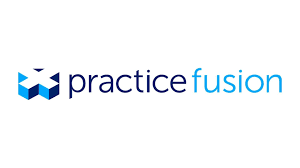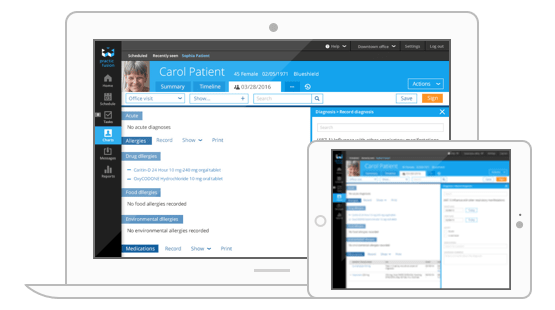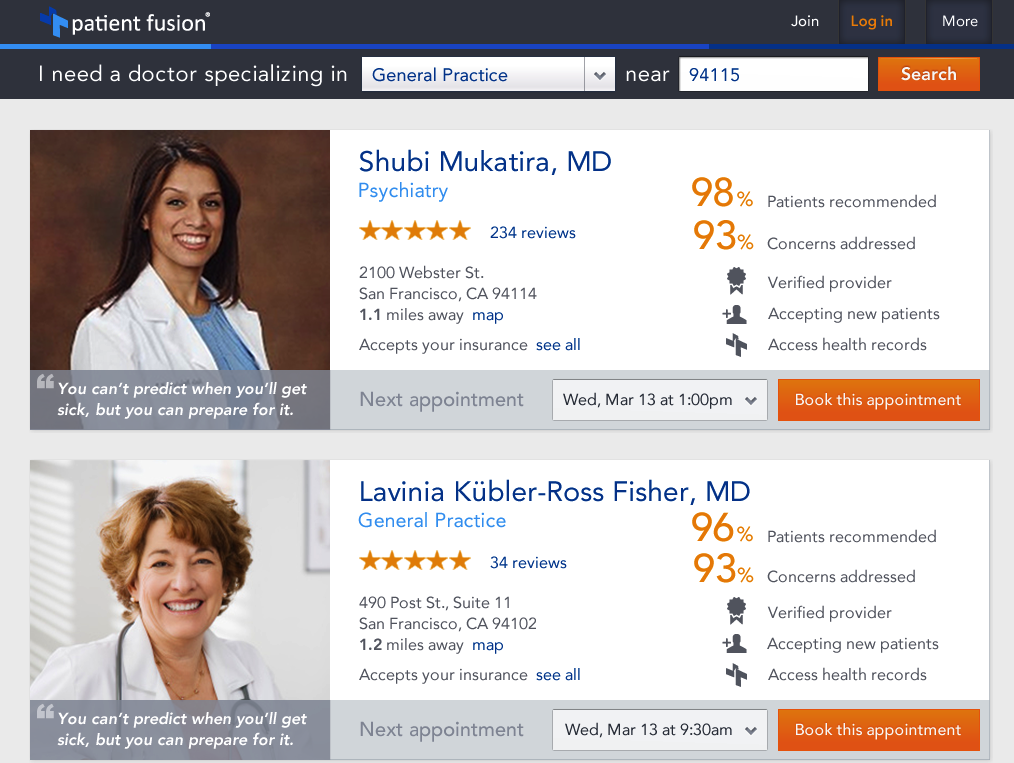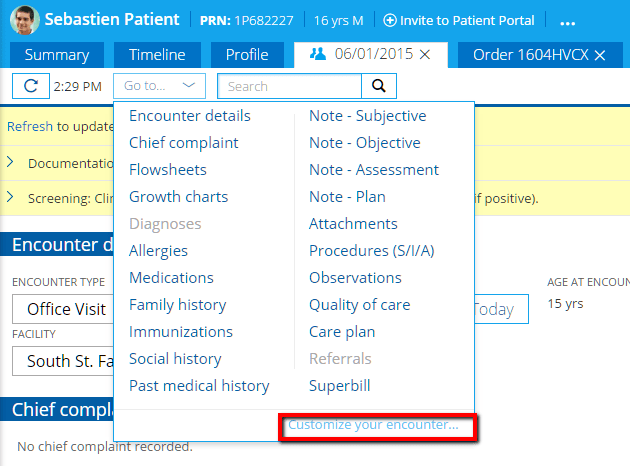What is Practice Fusion?
Practice Fusion is a free cloud-based electronic health record (EHR) system used by medical practices to connect health professionals, patients, and data. According to Practice Fusion’s website, they “offer services that make modern healthcare better for everyone,” including pharmacies, labs and imaging centers. Despite this claim, should your medical practice use the Practice Fusion system? To help you decide, we’ll explore some advantages and disadvantages of using Practice Fusion for your medical practice.

About Practice Fusion
Firstly, here’s some background information about Practice Fusion. Founded in 2005, Practice Fusion was developed to remove some of the frustration of operating a medical practice. The founders recognized that in addition to providing patients with the best possible care, a lot of time was wasted dealing with the following types of tasks:
Administrative
Technological
Financial
The Practice Fusion system claims that the following features enable more efficient medical practice management:
E-prescribing
Scheduling
Intuitive charting
Billing
Personal health record for patients
Lab integrations
Prescribing
Eligibility checks
To provide a more comprehensive product offering to medical practitioners, Practice Fusion has partnered with over 600 companies including:
Dell – offers medical practitioners special deals on computer hardware like scanners, tablets, and printers for your medical office. With Dell and Practice Fusion – the transition from paper charts to electronic records is easy and affordable.
Cooper – created a mobile, tablet-based addition to Practice Fusion’s web app for medical practitioners to enable quicker data entry with tools like smart defaults and intelligent templates.
Practice Fusion Acquisition

With more than 112,000 medical professionals using Practice Fusion and over 600 partners, the company has been acquired by Allscripts. Practice Fusion was acquired for $100 million, and the deal is expected to be finalized in the first quarter of 2018.
Allscripts, a large EHR company, believes that this acquisition will help to grow its big data and analytics capacity. Allscripts President, Rick Poulton, stated, “Combined with Practice Fusion, we expect Allscripts to continue to drive innovation in addressing gaps-in-care, improving clinical outcomes and real-world-evidence research.”
Mr. Poulton also added that “Allscripts’ highest priority remains to successfully meet healthcare providers’ highly complex needs as we enable them to lead the change to smarter care.”
Given that the acquisition has yet to be finalized, it’s difficult to predict how the new ownership will affect medical practitioners who use Practice Fusion. It’s generally expected that there will be some changes when a company is acquired. However, if the main features of Practice Fusion remain the same, here are some pros and cons of using it in your medical practice.
Should your medical practice use Practice Fusion?
Here are some of the advantages of using Practice Fusion in your medical practice:
The disadvantages of using Practice Fusion in your medical practice:
Advantages:
Free of charge
Depending on the features your medical practice needs, most EHR systems will incur variable costs. Although most EHR systems for medical practices are paid via a monthly subscription, there can also be upfront costs like activation or initial licensing fees. The price of EHR systems vary greatly and range from free to hundreds of dollars per month.
One benefit of Practice Fusion is that it’s free of charge for medical practitioners. Neither you nor your patients will be charged for using this system. Practice Fusion is a business and therefore needs to make a profit to be sustainable. So, how does the company make money if medical practitioners or patients aren’t charged? The answer is that Practice Fusion is backed by private investors and it uses advertising as its main business model.
In 2013, the then VP of Marketing Communications at Practice Fusion, Emily Peters, stated:
“Most physicians typically use our EHR platform for six to eight hours a day. Advertisers find this to be an extremely attractive marketing vehicle because they know they are getting in front of a captive, and historically hard to reach, audience. Advertisers can even target their messages to reach physicians in specific specialties.”
The ads are designed to be unobtrusive to avoid interrupting your workflows. Banner ads are limited and there are no pop-up ads. There’s one ad on the screen, which changes when you navigate to a different screen.
It’s alleged that Practice Fusion also generates revenue by allowing companies to access data from the 80 million patient records on its systems. Patients’ identities are protected because the information is stripped of identifying details. This data helps companies to conduct research on issues like drug choice.
Given their revenue model, Practice Fusion may be a good option for your medical practice, if you:
Want a free EHR system.
Aren’t put-off by ads.
Are satisfied with how your patient’s data will be used.
Higher level of productivity and efficiency
Paper-based medical practice management is being phased-out as 79% of healthcare providers report their practice runs more efficiently with EHR. Managing your practice with an EHR system, like Practice Fusion, provides the convenience of centralized chart management with access to patient records on any device, anywhere and at any time. Productivity is increased with Practice Fusion, as communication with other medical professionals such as diagnostics centers, pharmacies, and insurance providers are maintained within one system. This facilitates more efficient communication with lost messages and emails becoming a thing of the past.
EHRs allow lab results to be recovered quicker, which saves both money and time. The likelihood of test results going missing is also higher with paper-based systems. On the other hand, the odds of misplaced results are reduced with EHRs, as the lab enters the information on the system and it’s directly accessible by the medical practice.
Practice Fusion has a feature for electronic prescribing or ‘e-prescribing.’ Paper prescriptions can be misplaced or misread. This doesn’t just lead to more administrative burdens, but can also endanger patients if the wrong medication or dose is given. E-prescribing enables medical practitioners and pharmacies to communicate directly, which:
Reduces errors
Saves time
Eliminates duplication
Another way that EHRs improve your medical practice’s efficiency and productivity is by replacing lengthy paper-based manual processes, like billing, with electronic workflows.

Better patient care
To determine whether you should use Practice Fusion in your medical practice, it’s important to discover how it will affect your patients. Practice Fusion has a dedicated portal to help patients play a more active role in their health. The portal allows patients to:
Book and manage appointments
Check-in
Access medication, test results, diagnoses etc.

As well as giving patients more control over their information, EHRs enable better patient care because multiple medical practitioners are able to access records at any time. The patient will no longer have to go through the inconvenience of completing the same paperwork over and over again. This approach reduces duplication and also provides the patient with a higher chance of being correctly diagnosed and better management of existing health conditions.
EHRs enable seamless tracking of important patient information like:
Allergies
Past procedures
Medications
EHRs, like Practice Fusion, also reduce medical errors since handwriting transcription isn’t required. The inconvenience associated with lost paper files are also done away with when using EHR systems.
EHRs can also perform a preventative function in relation to better patient care. For a proactive approach to their healthcare, the patient can receive automated messages to remind them of follow-up appointments and screenings.
Extra financial savings
As well as making a saving on using a free EHR system, like Practice Fusion, your medical practice can also enjoy additional savings. Using electronic records means there’s no need to buy new filing cabinets or pay for secure storage for your patients’ records.
You’ll also spend less on costly medical chart materials because charts are provided in electronic format.
Another area that your medical practice can make a saving on when implementing Practice Fusion is on staff peripheral costs. Since unnecessary administration tasks are eliminated with EHR, you may find that you need fewer employees. Alternatively, you can utilize your existing staff to carry out tasks that will help grow your medical practice.
Disadvantages:
Data privacy concerns
As noted above, Practice Fusion allegedly sells anonymous patient data to other medical professionals. However, Practice Fusion settled the Federal Trade Commission charges that it publicly disclosed personal and sensitive patient information. This case came about when Practice Fusion launched a doctor review site called Patient Fusion, with over two million patient reviews and 30,000 doctor profiles. Some doctors advised that they were surprised by the new site because they were unaware that the site was soliciting reviews from their patients. They added that they were only aware of Practice Fusion’s interaction with patients in relation to prescription reminders and appointments.

The reviews on the site contained sensitive patient information – some even included names and contact details. The nature of some of the reviews implies that patients were unaware that their reviews would be made public. Therefore, it appears that both doctors and patients were in the dark about the intentions behind the request for reviews. Furthermore, it was also claimed that Practice Fusion’s actions violated the Health Insurance Portability and Accountability Act (HIPAA). A spokesperson for Practice Fusion, VP of Marketing and Communications, Emily Peters, advised that the emails were compliant with HIPAA.
Practice Fusion’s use of patient’s email addresses and information was questionable due to the fact that both medical practitioners and patients were not clear as to how their information would be handled. Unfortunately, some regard this type of episode as the price that medical practitioners pay for ‘free’ EHR systems because, in the end, nothing is really free.
Security issues
As well as the reported misuse of patient’s information by Practice Fusion, there’s also concern about outside parties accessing sensitive information contained in EHR systems. Hackers could access personal medical data, which they will threaten to release if the medical practitioner doesn’t pay a ransom. Last year, hackers compromised the UK’s NHS computer system – one of the largest in the world. Over 40 hospitals were affected by ransomware, with hackers requesting payment to get the system back online. Given this environment, it’s understandable that some patients and medical practitioners are concerned about the safety of their information.
Practice Fusion state that they recognize this concern and that data security is their number one priority. They’ve made the following statements to reassure medical practitioners:
Their industry-leading data system security includes data centers with biometric security, redundant power supplies, data back-ups and non-stop surveillance systems. Data transfers include the highest level of encryption for protection against malicious attacks.
Compliant with HIPAA by meeting or exceeding every HIPAA and proposed HHS certification requirements. They also keep an eye on federal and state regulations to make sure that medical practices remain compliant.
Secure access to your Practice Fusion account is regulated by strict user access levels. This gives you the reassurance that only the right people access the appropriate information. There’s also an audit function –via a live activity feed – so you can review who has accessed the system.
Security is a major concern for every industry, however, it’s particularly unsettling in relation to the healthcare industry because of the extremely sensitive nature of the data involved. Unfortunately, due to the nature of cloud-based EHR software, the risk of hacking can’t be totally mitigated. The security of your patient’s data is something you have to seriously consider when deciding whether to use Practice Fusion (or any other EHR in your medical practice).
Cookie-cutter systems
No two medical practices are the same. You’ll be accustomed to using certain documentation, which may not be customizable in your EHR system. A lack of customization will make learning how to use the new EHR system more difficult. It’s important for your EHR system to allow you to customize as many features, templates and documentation as possible. To ensure that the transition from paper to a system like Practice Fusion is as smooth as possible, review all the customization options to make sure that it will be suitable for your medical practice and your team.
Practice Fusion offers the following customizable options:
Template builder
Chart views
Reminder tasks
Chart notes
If you want a customized EHR, Practice Fusion offers a variety of changeable options to suit your needs. When deciding whether to implement Practice Fusion in your medical practice, you’ll need to consider whether this customization goes far enough.

Final Thoughts
We’ve explored the most common benefits and disadvantages of Practice Fusion. To help you with the decision of whether you should use it in your medical practice, here are a handful of reviews from Practice Fusion users. These user experiences were taken from the software review site Capterra. Please note that we have no way of verifying the following reviews, so please check them out for yourself:
Pros: “It’s totally free, and it’s easy to use as a customer/patient. Patients can easily update their own information, view their health records, and it’s easy to train new staff to use this software as well.”
Cons: “The scheduling feature sometimes gets a little buggy, but it’s free software with lots of great features!”
Pros: “Practice Fusion has custom templates, easy to learn and use, and was easy to transition from our paper charts. The feature to prescribe medications and look up pharmacy locations is great. Scheduling is a breeze compared to paper calendars and organizers.
Cons: ”Sometimes, when you save something, it closes out and doesn’t actually save. It’s probably just a glitch, but losing notes is time-consuming.”
Pros: “It’s free and our tiny practice could not afford to buy software. I can use it from home. I can check it for inactive patients.”
Cons: “Scheduling still has glitches where appointments get erased mysteriously. It takes forever to get useful changes made.”
As you’ll note from two of the reviews above, scheduling patients in Practice Fusion can be a source of frustration. If you’re experiencing similar issues scheduling your medical practice employees, consider giving Deputy a try.
Also, if you’re persuaded to use Practice Fusion in your medical practice to handle patient information and appointments but you still need a reliable workforce management solution to schedule your team members, then sign-up for Deputy’s free trial.
<div class="chili-piper aligncenter new-branding"><a class="btn btn-orange" style="padding: 15px 25px 14px; letter-spacing: 1px;" href="#chili-piper">SET UP A TIME TO CHAT</a></div>
